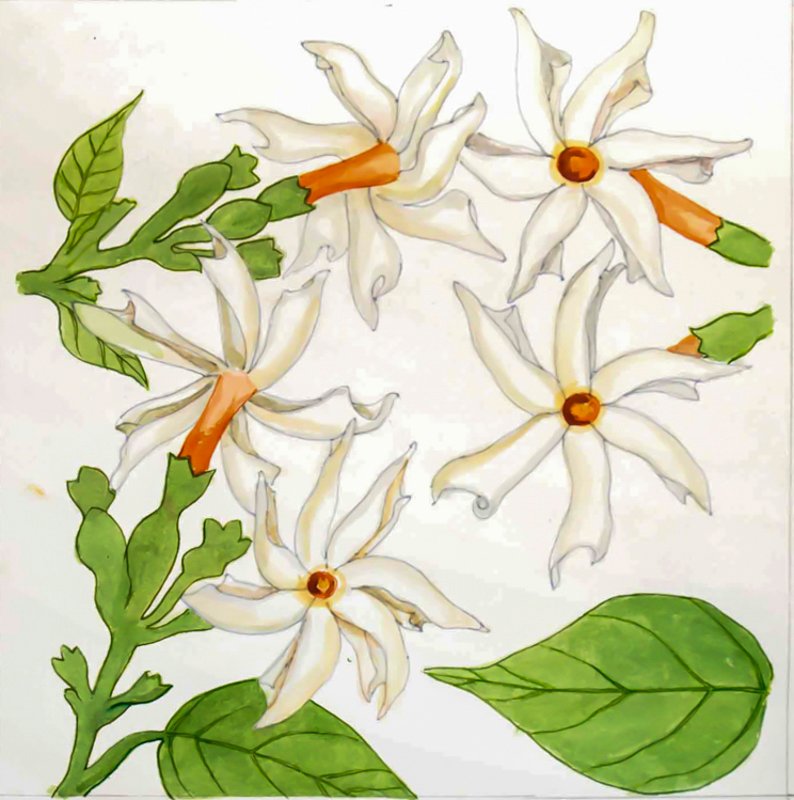Pillar Eight
Artwork by A. Manivelu
Top

NORTH FACE:
Arjuna TreeArjuna tree, Terminalia arjuna, was introduced into siddha medicine by saint Agastiyar through his prose Gunavakatam and in Ayurveda as a treatment for heart disease by Vagbhata (c. 7th century CE). It was mentioned in many ancient Indian vedas, and was a known medicine for thousands of years. Vagbhata mentions arjuna in the treatment of wounds, hemorrhages and ulcers, applied topically as a powder. It has traditionally been used to treat heart disease for centuries, which is why it got the nickname “Guardian of the heart.”

EAST FACE:
PadukaHere we see the revered sandals called paduka or tiruvadi. Shri Paduka refers to the sandals of the preceptor; they are a traditional icon of the guru, representing his venerable feet and worshiped as the source of grace. Paduka also names one of Vira Saivism’s eight aids (ashtavaranam) to faith—the practice of drinking the water from the ceremonial ablution of the Sivalinga or the guru’s feet.

SOUTH FACE:
Hong Kong OrchidThis is the bauhinia, also known as Hong Kong orchid. Many species are widely planted in the tropics as orchid trees, particularly in India, Sri Lanka, Vietnam and southeastern China. It is among the most popular flowering trees on Kauai.

WEST FACE:
Coral JasmineThe parijatham, also called coral jasmine (Nyctanthes arbor-tristis), is a night-flowering jasmine or parijat or hengra bubar native to Southeast Asia. It is the official state flower of West Bengal. In India women lay a sari on the ground beneath the bush early in the morning, then shake the branches. Hundreds of fragrant white and orange flowers fall and are gathered to take to the temple as an offering, or to use in the home puja. There are several here in Siva’s Sacred Garden.
1 of 4
Middle

NORTH FACE:
BhulokaThe bhuloka is the world or the physical plane. It is the physical world perceived through the five senses. Also called the First World. Here a pundit lives, acts and writes in the First World of existence.

EAST FACE:
AntarlokaThis is a deva in the inner plane or in-between world, called the Antarloka, astral plane or Second World.

SOUTH FACE:
SivalokaThe image here is a profile of God Siva and represents the realm of Siva, known as the Sivaloka. Siva’s loka—which means “habitat, region or level of existence.” Known as the causal plane or Third World, the Sivaloka is the abode of Siva, the Mahadevas and highly advanced souls. It exists deep within the Second World.

WEST FACE:
NarakalokaThis is an instinctive being and resident of the Narakaloka, the abode of darkness. Literally, “pertaining to man,” the nether worlds are the rough equivalent of the Western term hell. It is a gross region of the Antarloka. Naraka is a congested, distressful area where demonic beings and young souls may sojourn until they resolve the darksome karmas they have created. Here, between births (and in future lives), beings suffer the consequences of their own misdeeds in previous lives. Naraka is understood as having seven regions, called tala, corresponding to the states of consciousness of the seven lower chakras.
1 of 4
Bottom

NORTH FACE:
Four perspectivesThis is Shum script for shumif, mulif, simnif and dimfi. It is a meditation in Gurudeva’s language of meditation and one of the 12 meditations he asked us to carve on the pillars. This is the February meditation. From top to bottom, Shumif is the perspective of the mind from the advaita viewpoint, the meditative viewpoint of being awareness flowing through the mind which itself is stationary. Mulif is the philosophical perspective of things, understanding theological, metaphysical and psychological concepts. Simnif is the view of science looking into matter; it includes knowledge of hatha yoga, pranayama and the currents of the physical body. Dimfi is the metaphysical view of looking into inner and outer space and is the arena of psychic experiences. It includes the consciousness of the Gods and inner-plane devas.

EAST FACE:
ChandeshwaraThis is the form of God Siva called Chandeshwara, a kind and benevolent aspect of Siva. The term is also used to refer to an attendant of Siva who is believed to have been a cowherd. It is stated that one who worships Chandeshwara will not have rebirth and will escape from all dangers and worries.
1 of 2
